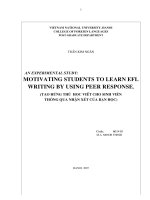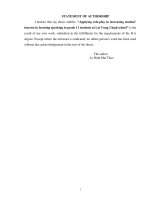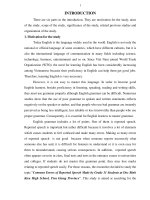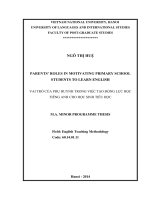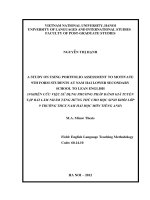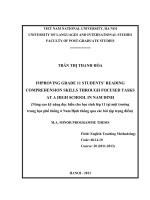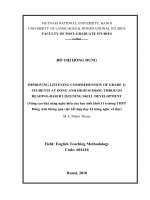Motivating grade 11 students to learn english through examination taking strategy training at yen thanh 2
Bạn đang xem bản rút gọn của tài liệu. Xem và tải ngay bản đầy đủ của tài liệu tại đây (235.44 KB, 46 trang )
1
PART A. INTRODUCTION
1. Rationale
Nowadays, in the era of the globalization and international exchange, English has become a
‘lingua franca’ which according to Jeremy Harmer (2001:1), can be defined as a language
widely adopted for communication between two speakers whose native languages are
different from each other’s and where one or both speakers are using it as a ‘second’
language. It has been used almost all over the world in many different areas such as
diplomacy, science, technology, business, culture, tourism, etc. There is no doubt that
English is one of the most important means of communication and access to information. In
this context, the teaching and learning of English is more and more necessary.
In Vietnam, in recent years, English as a foreign language has gained considerable attention.
It has become a compulsory subject in the syllabus of many schools, colleges and
universities. It has been taught and learnt throughout the country, both urban areas and rural
(or remote) ones. Even in the countryside, children now start learning English when they are
in grade 3 or 4. However, the fact is that the teaching and learning of English has not been
effective yet, especially that in rural areas. There are still many people who cannot use
English well after finishing English courses.
As a teacher of English at a rural upper secondary school, the researcher is concerned about
her students’ English learning. She has been teaching 4 classes of grade 11. Although her
students have learnt English since they were in grade 6 under the new syllabus and new
methods based on the communicative approach, their English is still not very good. Of
course, they can hardly use English to communicate. Also their marks in tests and
examinations are rather low. Additionally, many of the students seem not to be interested in
learning English. According to them, English is difficult and not very necessary for their
future, because after school most of them will be farmers or workers only. In other words,
they do not have much motivation for learning it. The practical goal for most of the students
is just to pass tests and examinations to graduate from the upper secondary school.
Moreover, the grade 11 students are the ones who are going to leave school in over one year,
so it is rather difficult to change their goal and motivation. The question is what teachers
should do to help their students learn English better in this environment, where the English
2
language input is limited and non-conducive to learning the target language. The researcher
has thought a lot about this fact, about the students’ goal and motivation. Wondering if
examination-taking strategy training can help to motivate the students, she decided to
conduct the study on “Motivating grade 11 students to learn English through examinationtaking strategy training at Yen Thanh 2 upper secondary school” to find out the answer, and
further, to help improve the teaching and learning of English at her school.
2. Research hypothesis
This study was designed to test the following hypothesis:
Examination-taking strategy training can help to motivate grade 11 students to learn English.
3. Aims of the study
The purpose of the study is to investigate the possibility of using examination-taking strategy
training to motivate grade 11 students to learn English at Yen Thanh 2 upper secondary
school. It aims specifically at:
- considering the student motivation and the reality of training and application of
examination-taking strategies in the context of grade 11 students at Yen Thanh 2 upper
secondary school.
- investigating changes in student motivation after applying examination-taking strategy
training in lessons.
- examining student attitude towards the examination-taking strategy training
- giving some recommendations for motivating students to learn English through
examination-taking strategy training
4. Significance of the study
The study is expected to make a better understanding of motivation to second language
learning. In addition, it offers the theoretical basis for language learning strategies,
examination-taking strategies, and the motivational roles of strategy training in general and
examination-taking strategy training in particular.
Practically and pedagogically, the findings of the study are believed to be useful for teachers
of English to be aware of the essential role of examination-taking strategy training to
students’ motivation in English learning. Besides, the recommendations for using
examination-taking strategy training to enhance students’ motivation, which are based on the
theoretical background and the current situation of learning English at Yen Thanh 2 upper
secondary school, hopefully can help the teachers motivate their students to learn English.
3
5. Scope of the study
Although there are many different ways to motivate students to learn English, all these issues
cannot be fully covered in this paper. Due to the limited time and the length of a minor
thesis, the researcher only focuses on exploiting examination-taking strategy training as a
way of motivating grade 11 students at Yen Thanh 2 upper secondary school. Besides, the
target that the study investigates and serves is just 115 students from 3 classes of grade 11 at
this school.
6. Methods of the study
This study was intended to conduct as a piece of action research. According to Gina Wisker
(2001), action research is research that we carry out with our students in order to try out an
idea or innovation, test a hypothesis about their learning and see ‘what would happen if...’.
Michael J. Wallace (1998) also points out that action research involves the collection and
analysis of data related to some aspects of our professional practice. With this action
research, the researcher used some different methods based on both quantitative and
qualitative approaches: survey questionnaires for students, consisting of one pre-treatment
questionnaire and one post-treatment questionnaire; follow-up interviews; classroom
observations.
The steps of the study are as follows:
(1). Spend one month collecting baseline data through classroom observations. These were
carried out by the researchers herself and some of her colleagues. Besides, get the students to
answer the pre-questionnaire to find out the reality of student motivation and their
knowledge of examination-taking strategies.
(2). Form the hypothesis that examination-taking strategy training can help to motivate grade
11 students to learn English.
(3). Provide the students with the examination-taking strategy training whenever possible in
the regular lessons for one month and half a month. The classroom observations were also
carried out by the researcher and her colleagues in this period.
(4). After one month and half a month, the students were invited to answer the postquestionnaire to find out the changes in their motivation as well as their attitude toward the
examination-taking strategy training. The follow-up interviews were also employed to gather
indepth information.
(5). Analyze the collected data and discuss the findings.
4
(6). Disseminate the outcomes.
7. Design of the study
The study is divided into three parts: the introduction, the development, and the conclusion
Part A: Introduction – presents the basic information including rationale, research
hypothesis, aims, significance, research methods, scope, and design of the study.
Part B: Development – consists of three chapters
Chapter 1: Literature Review – provides the literature concerning motivation in
second language learning, learning strategy training, and examination-taking strategy
training as a motivating factor.
Chapter 2: The study – reports the setting, research hypothesis, participants,
instruments, data collection procedure and analysis. The detailed results of the surveys and a
critical comprehensive analysis on the data collected are presented.
Chapter 3: Major findings, discussions and recommendations for motivating
students to learn English through examination-taking strategy training – shows major
findings and discussions and offers recommendations for motivating students to learn
English through examination-taking strategy training.
Part C: Conclusion – is a summary of the study in which limitations of the study and
suggestions for further research are presented.
PART B. DEVLOPMENT
CHAPTER 1: LITERATURE REVIEW
5
1.1. Overview of motivation in language learning
1.1.1. Definitions of motivation
Motivation is accepted for most fields of learning to be essential to success. Without
motivation we will almost certainly fail to make the necessary effort. Therefore, it makes
sense to try and develop our understanding of it.
Motivation is defined in different ways by different researchers. According to Marion
Williams and Richard Burden (1997:120), motivation is a ‘state of cognitive arouse’ which
provokes a ‘decision to act’ as a result of which there is ‘sustained intellectual and/or
physical effort’ so that the person can achieve some ‘previously set goal’. Sharing the same
view, Jeremy Harmer (2001:51) states that ‘at its most basic level, motivation is some kind
of internal drive which pushes someone to do things in order to achieve something.
Additionally, Woolfolk (2001:366) defines motivation as ‘an internal state that arouses,
directs and maintains behavior’.
Briefly, motivation is something involving the attitudes and affective states that influence the
degree of effort that one makes to achieve some certain goal. It is not only arousing interest
but also sustaining interest and investing time and energy into putting the effort to achieve
those goals.
1.1.2. Importance of motivation in language learning
Learner motivation has become more commonly recognized as perhaps the major
determining factor for successful learning in general, whether one is an adult learner taking
distance education courses, or an upper secondary school student pushing one’s way through
the battery of required courses needed to graduate. It has been found in various studies that
motivation is very strongly related to achievement in language learning. As William T.
Littlewood puts it (1984:53), ‘in second language learning as well as in every other field of
human learning, motivation is the crucial force which determines whether a learner embarks
on a task at all, how much energy he devotes to it, and how long he perseveres’. Besides,
Tricia Hedge (2000:23) affirms: ‘motivation is of crucial importance in the classroom,
whether learners arrive with it or whether they acquire it through classroom experiences’.
About this issue, Oxford and Shearin (1996:121-122) also argue: ‘Motivation is important
because it directly influences how often students use L2 learning strategies, how much
students interact with native speakers, how much input they receive in the language being
6
learned (the target language), how well they do on curriculum-related achievement tests,
how high their general proficiency level becomes, and how long they persevere and maintain
L2 skills after language study is over. Therefore, motivation is crucial for L2 learning, and it
is essential to understand what our students’ motivation are’. As a result, motivation should
be paid attention in teaching and learning second languages.
1.1.3. Common factors affecting learners’ motivation in language learning
There is a variety of factors affecting learners’ motivation such as parents, community,
learning context, teacher, subject, etc. However, in this paper, the researcher only focuses on
some common and important factors, namely, learner’s factors, teacher’s factors, learning
materials and learner’s success in second language learning.
1.1.3.1. Learner’ factors
Among these factors, the first and most important factor is their background knowledge.
Background knowledge refers to the existing information on a specific topic in each
language lesson. Therefore, if students lack background knowledge, it is difficult for them to
get involved in learning activities. They will be unable to comprehend new materials and
more importantly, they will lose their interest in learning lessons. Realizing the influence of
this factor, the teacher needs to provide the amount of background information available and
to see that they are able to use them.
Besides, language items such as vocabulary and grammatical structures can be considered to
have an impact on the students’ feelings. This causes difficulties in getting meaning as well
as practicing language skills.
The student’ aptitude is also an important factor that influences his motivation. If one finds
he is able to do something well, surely he feels self-confident and likes it very much. The
other factor is learners’ language learning strategies. Learners’ strategies can affect their
mood to participate actively in learning activities. Strategies are helpful to students because
they enable them to improve their learning proficiency as well as efficiency in learning.
Moreover importantly, strategies help learners to process the lessons actively and to connect
what they are learning to their own knowledge. However, learners must be flexible in
employing strategies; otherwise, their expectations to the learning are not met. In addition, it
is true that more highly motivated learners use a significantly greater range of appropriate
strategies than less ones. It is advisable for teachers to teach learners strategies in lessons and
let them practice frequently.
7
1.1.3.2. Teacher’ factors
Teachers are considered to have very important responsibilities in making sure the learners
remain happy and interested in learning.
The first factor is the teacher’s attitudes and behaviors towards students. The way the teacher
feels, thinks and behaves while teaching can have a profound effect on learners’ motivation
and learning atmosphere. When the teacher has personal and interpersonal variables such as
good mood, warmth, respect, empathy, understanding, sensitivity, enthusiasm and good
sense of humor, the learning atmosphere is likely to be relaxing, enjoyable, and conducive to
language learning. It is suggested that when learners see an instructor who is excited about
his/ her subject or who simply loves teaching, inevitably they are affected by this energy and
will engage themselves actively in the learning process. Moreover, when teachers have
expectations in their students’ ability, the learners are likely to reach high level of
achievement and feel more confident. Learners tend to perform at a level that is consistent
with the teacher’s belief and expectations.
Besides, the teacher’s techniques and activities are of great impact on learners’ motivation.
Without good techniques and interesting activities, learners may be left in confusion and
boredom while dealing with learning tasks. Therefore, teacher should invest more effort and
thoughts in the materials, the ways, and the time to use techniques and activities carefully for
a specific stage of teaching and assessing the learning performance.
Lastly, the teacher should be aware of learners’ learning needs, consisting of their motivation
for learning and the purposes that language learning has in their lives. A good teacher should
be the person who can find ways to pull the students and the lesson together.
1.1.3.3. Learning materials
One of the most important factors which influence the learners’ motivation is learning
materials. The materials which are interesting and relevant to the learners will motivate them
to learn more. For example, when learners have to face a text or a task beyond their language
proficiency with many unknown words and complex sentences, they become overwhelmed,
frustrated and tired. Besides, if the topic or content of the text is not interesting, familiar and
relevant to their experience and interests, they may stop learning. What’s more, the lack of
variety in task types also makes learners reluctant to engage fully with the activity.
1.1.3.4. Learner’s success in language learning
8
It is realized that motivation for language learning could be much enhanced with success.
According to Ur (1996:278), “learners who have succeeded in past tasks will be more
willing to engage with the next one, more confident in their chances of succeeding, and more
likely to preserve in their efforts”. Jeremy Harmer (2001:52) also affirms that ‘nothing
succeeds like success’ so ‘if the teacher can help students in the achievement of short-term
goal, this will have a significant effect on their motivation’. Obviously, it is better for the
teacher to appreciate students’ success.
1.2. Overview of examination-taking strategy training
1.2.1. Language learning strategy training
1.2.1.1. Definitions of language learning strategies
A lot of research into language learning strategies has been done since 1960s. Up to now the
term ‘language learning strategy’ has been defined by many researchers. In Wenden and
Rubin’s words (1987:19), language learning strategies are defined as “…any sets of
operations, steps, plans, routines used by the learner to facilitate the obtaining, storage,
retrieval, and use of information.” Stern (1992:261) states that “the concept of learning
strategy is dependent on the assumption that learners consciously engage in activities to
achieve certain goals and learning strategies can be regarded as broadly conceived
intentional directions and learning techniques.” According to Chamot (2004:14-26),
“learning strategies are the conscious thoughts and actions that learners take in order to
achieve a learning goal”. Oxford (1990:17) divides strategies into major types, direct and
indirect. She defines direct strategies as those requiring mental processing of the language.
However, the three groups that compose direct strategies do this processing differently and
for different purposes. For example, memory strategies, such as grouping or using imagery,
have a highly specific function, which is to help students store and retrieve new information.
Cognitive strategies, on the other hand, such as summarizing or reasoning deductively,
enable learners to understand and produce new language by many different means. Finally,
compensation strategies like guessing or using synonyms, allow learners to use the language
despite their often-large gaps in knowledge. The second group of strategies discussed by
Oxford is indirect strategies. These are called “indirect” because they support and manage
language learning without directly involving the target language. They are divided into
metacognitive, affective, and social strategies. Metacognitive strategies, like centering your
learning and evaluating and monitoring, are “actions which go beyond purely cognitive
9
devices, and which provide a way for learners to coordinate their own learning process”
(1990:136). Affective strategies, however, such as lowering your anxiety, encouraging
yourself, and taking your emotional temperature, deal with emotion, attitudes, motivations,
and values. Finally, the third indirect strategy group defined by Oxford involves social
strategies, like asking questions, cooperating peers and proficient users of the target
language, and empathizing with others.
It is accepted that providing learners with learning strategies is very important. Language
learning strategies are good indicators of how learners approach tasks or problems
encountered during the process of language learning. Developing skills in these areas, such
as metacognitive, cognitive, social and affective can help the language learner build up
learner independence and autonomy whereby he can take control of his own learning.
1.2.1.2. Strategy training as a motivating factor
Since learning strategies in general and language learning strategies in particular are very
important, it makes sense to help learners know and use them well. In other words, providing
learners with learning strategies are necessary. Research indicates that language learners at
all levels use strategies, but that some or most learners are not fully aware of the strategies
they use or the strategies that might be most beneficial to employ. When learners become
aware of the range of strategies from which they can choose during language learning and
use, they will have many opportunities to succeed. Success will help enhance learners’
motivation. On the other hand, when learners know how to use strategies, they will become
more self-confident. One of the strategies to boost learners’ motivation suggested by
Woolfolk (2001:421) is building learners’ confidence and positive expectation. With
success, the confidence will certainly help improve students’ motivation. Therefore, it can be
said that learning strategy training is a motivating factor.
1.2.2. Examination-taking strategy training
1.2.2.1. Definitions of examination-taking strategies
Although the term “examination” and “test” are distinguished as different terms in many
cases, in this paper “examination-taking strategies” and “test-taking strategies” are
considered the same. They are used to refer to strategies exploited in test situations.
According to Andrew D. Cohen (1998:219), “test-taking strategies consist of both language
use strategies and test-wiseness strategies”. He points out that language use strategies are
steps or tasks that learners consciously select in order to accomplish language tasks, and
10
include retrieval strategies, rehearsal strategies, cover strategies, and communication
strategies. All four types of strategies are used in test taking, since respondents need to
retrieve material for use on the test, may need to rehearse it before using it (such as in
speaking or writing tasks), are likely to use some cover strategies in order to look good, and
may well to engage in genuine communication if the tests or quizzes call for it. In Cohen’s
view, these various language use strategies constitute test-taking strategies when they are
used to help produce responses to testing tasks. The second group of test-taking strategies is
test-wiseness. These strategies are not necessarily determined by proficiency in the language
being assessed, but rather may be dependent on the respondents’ knowledge of how to take
tests. One such test-wiseness strategy consists of opting out of the language task at hand (e.g.
through a surface matching of some information in the passage with the identical
information in one of the response choices). A second strategy would be to make use of
material from a previous item when it ‘gives away’ the answer to a subsequent one. This is
also a form of matching, but across items rather than within them, and, as in the previous
case, the respondent may make the match without understanding the material very well or at
all. Another test-wiseness strategy consists of taking shortcuts to arrive at answers (e.g. not
reading the text as instructed but simply looking immediately for the answers to the given
reading comprehension questions).
In Mc Donough’s words (1995:105), these strategies are called test-wise, i.e. “having some
ingenuity, knowledge, or strategy to outwit the tester and find the right answer from the
clues in the test format rather than from actual knowledge of the language or skill in
language use.
In short, examination-taking strategies or test-taking strategies are the strategies the testtaker uses to take the test, including language use strategies and test-wiseness ones.
Language use strategies are considered close to the learner’ competence while test-wiseness
ones are sometimes not. Despite this fact, in many cases test-wiseness can help test-takers a
lot. As Cohen (1998:218) puts it, the strategy of studying the questions carefully before
reading the text may be crucial for the particular respondents, especially the ones who do not
have good retentive memory when they read in that language. In the other words, in some
cases, test-wiseness strategies can well supplement language use strategies.
1.2.2.2. Examination-taking strategy training as a motivating factor
11
There is no doubt that test-taking strategies are very important, especially for the students,
for whom tests are a fact of life. Thus, it is very essential for teachers to provide students
with test-taking strategy training. Knowing and using test-taking strategies well will help
them to become more confident and lower anxiety. Besides, well-equipped test-taking
strategy students surely get high marks in tests, that is, succeed in their learning. Moreover,
one of students’ certain goals is passing tests and examinations. Test-taking strategy training,
therefore, is their interest and meets their needs. As mentioned in the parts above, all of these
things such as confidence, success, interest, etc. will motivate them to actively engage in
learning process. Briefly, test-taking strategy training is really a motivating factor for
students’ learning.
1.2.3. Principles to provide students with examination-taking strategy training
Before conducting the test-taking or examination-taking strategy training, it is essential to be
well aware of its aims.
According to Cohen (2003), strategy training aims at providing learners with the tools to do
the following:
•
Self-diagnose their strengths and weaknesses in language learning
•
Become aware of what helps them to learn the target language most efficiently
•
Develop a broad range of problem-solving skills
•
Experiment with familiar and unfamiliar learning strategies
•
Make decisions about how to approach a language task
•
Monitor and self-evaluate their performance
•
Transfer successful strategies to new learning contexts
He then presents three different instructional frameworks of conducting strategy training
proposed by Pearson and Dole (1987), Oxford et al. (1990), and Chamot and O’Malley
(1994). As he puts it, each of these three frameworks has been designed to raise student
awareness of the purpose and rationale of strategy use, give students opportunities to practice
the strategies they are being taught, and help them use the strategies in new learning context.
Oxford (1994) suggests some principles of language learning strategy training as follows:
•
Language learning strategy training should be based clearly on students’ attitude,
beliefs, and stated needs.
12
•
Strategies should be chosen so that they mesh with and support each other and so
that they fit the requirements of the language task, the learners’ goals, and the
learners’ style of learning
•
Training should, if possible, be integrated into regular language learning
activities over a long period of time rather than taught as a separate, short
intervention.
•
Students should have plenty of opportunities for strategy training during
language classes
•
Strategy
training
should
include
explanations,
handouts,
activities,
brainstorming, and materials for reference and home study
•
Affective issues such as anxiety, motivation, beliefs, and interests-all of which
influence strategy choice-should be directly addressed by language learning
strategy training.
•
Strategy training should not be solely tied to the class at hand; it should provide
strategies that are transferable to future language tasks beyond a given class.
•
Strategy training should be somewhat individualized, as different students prefer
or need certain strategies for particular tasks.
•
Strategy training should provide students with a mechanism to evaluate their
own progress and to evaluate the success of the training and the value of the
strategies in multiple tasks.
As a type of language learning strategies, test-taking strategies can be trained on the above
basis. In addition, in Matter’s view (1986:1), “Ideally, test preparation activities should not
be additional activities imposed upon teachers. Rather, they should be incorporated into the
regular, ongoing instructional activities whenever possible”.
To sum up, the teacher should take these issues in consideration before providing students
with test-taking strategy training.
The chapter has presented issues and aspects concerning the topic of the study. It has
discussed the concepts and ideas relating to motivation in general and in second language
learning in particular. What’s more, common factors affecting students’ motivation in
language learning have reviewed. Besides, given the purpose of the study, the author mainly
focuses on the discussion of strategy training, especially taking strategy training as a
13
motivating factor. The following chapter will display the methodology of the research under
the light of the above discussed theories.
CHAPTER 2. THE STUDY
2.1. The setting of the study
2.1.1. The syllabus and assessment
This study was conducted at Yen Thanh 2 upper secondary school, a rural school of Nghe
An province, where the environment for teaching and learning English was limited.
Although English has been taught and learnt as a compulsory subject here for 8 years, it has
14
been rather new and difficult for the students. Like in many other schools in Vietnam, there
exists two kinds of syllabus here: the old one for the current grade 12 students and the new
one for the current grade 10 and 11 students. The school year 2007-2008 is the last one when
the old syllabus is taught and learnt, after that the new syllabus will be completely covered
the grades. The new syllabus with the communicative approach is considered interesting but
rather challenging for the teachers. It mainly focuses on equipping students with
communicative ability and competence to perform basic language functions receptively and
productively, using correct language forms and structures. In the new textbooks, the new
syllabus content is arranged according to themes. Most of the themes are considered to be
rather close to the contexts of the students’ daily life such as home, school, recreation,
community, and the natural and social world. Each unit in the new textbooks has 5 lessons: 4
for 4 skills – reading, speaking, listening, writing and 1 for language focus. In general, it is
agreed that the new syllabus has a lot of improvement as compared to the old one. However,
the current examinations, especially final ones, are almost in the format of multiple-choice
questions and mainly focus on grammar, vocabulary, pronunciation, reading comprehension
and some controlled writing, but not listening and speaking skills. This makes the English
lessons at class, especially listening and speaking lessons become boring and useless for
students while the teachers are wavering without knowing how they should teach to gain the
best results.
2.1.2. The teachers
In Yen Thanh 2 upper secondary school there are totally 9 teachers of English aged 23 to 45.
All of them have got the University Bachelor’s Degree but their time lengths of teaching
English are different. The oldest teacher has nearly 25 years of teaching experience, and the
youngest just has nearly one year. As rural teachers, they have few opportunities to upgrade
their teaching and do not have a lot of teaching aids and materials to help their work. Despite
all these disadvantages, they are always eager for knowledge and willing to adjust to new
thinking and apply better ways to improve their teaching quality. Especially, all of them took
part in the in-service training workshop of curricular innovation organized by Nghe An
Department of Education and Training.
2.1.3. The students
Most of the students at Yen Thanh 2 are from farmer families so their lives are rather poor.
They do not have enough good conditions to learn, especially to learn English. Apart from
15
learning, they have to help their families with housework and farming. The current grade 12
students have been learning English for 3 years but their English is very bad. The ease of old
examination rules has made them lazy since they began learning English in grade 10 and
now in their opinion they really “have no head for English”. The current 10 and 11 students
seem more worried when these rules are stricter and stricter but their learning has not been
improved yet. Although they have been learning English under the new syllabus with new
textbooks for nearly six years (from Grade 6), English is still something difficult and strange
to them. To learn English well, the environment for learning is very important. However,
they hardly have opportunities to use English outside the English classes. Moreover, their
parents, the actual farmers, who hardly know anything about English, do not encourage them
to learn it. As a result, most of the students do not know what they learn English for, except
for the reason of passing the final examination. They do not know its importance in the
modern life as well as in their future. They become bored with learning it. In each class,
there are only a few students really learning English and being interested in learning it. The
rest almost forget all the things they have learnt. Once the learners have no motivation for
learning, the learning quality is very difficult to be improved.
2.2. Research hypothesis
As presented above, this study was designed with the aim of testing the following
hypothesis: “Examination – taking strategy training can help to motivate grade 11 students to
learn English at Yen Thanh 2 upper secondary school”
2.3. Participants
There are two samples of participants in this study: participants for the survey questionnaires
and participants for the follow-up interviews.
The participants for the survey questionnaires were 115 students from 3 classes of Grade 11
at Yen Thanh 2 upper secondary school, including both male and female ones. They were all
from the countryside. They have been learning English under the new syllabus with the new
textbooks since they were in Grade 6. When participating the study, the students were in the
second term of the school year. In the researcher’s observation, their English proficiency was
at the average level as compared with the other grade 11 students of the school. The
researcher was the third teacher to teach these students. It means that the students had
chances to learn with many different teaching methods and styles from different teachers.
16
The selection of participants for the interviews was based on the survey data so that 2
participants who reported the least changes and 8 who reported the most changes in attitudes
and motivation were interviewed for more insights into the effect of examination-taking
strategy training as a motivating factor. More participants with attitudinal changes in
comparison with the unchanged were selected so as to be more convenient in verifying how
those changes could take place.
2.4. Data collection instruments
Given the aim of the study, the researcher used two main kinds of research instruments:
questionnaires for students and follow-up interviews. Besides, class observations were also
employed to supplement the above instruments.
2.4.1. Questionnaires
Questionnaires were employed in this study to test the researcher’s hypothesis. According to
Bill Gillham (2000:6), using questionnaire has some advantages: low cost in time and
money; easy to get information from a lot of people very quickly; respondents can complete
the questionnaire when it suits them; analysis of answers to closed questions is
straightforward; less pressure for an immediate response; respondents’ anonymity; lack of
interviewer bias; standardization of questions (but true of structured interview); can provide
suggestive data for testing an hypothesis.
The questions were designed in both close and open-ended forms. Among them, some
questions have more than one answers that can be accepted so that respondents can have
more freedom to express their own ideas. All the questions were written in Vietnamese to
assure that respondents did not have any language problems in understanding the
questionnaire items.
In this study, two questionnaires were designed to gather the needed dada: one delivered
before and one delivered after the treatment.
2.4.1.1. Pre- questionnaire
The pre-questionnaire included 15 questions arranged into 3 parts. Part I aimed at eliciting
information about the respondents’ background containing their name, the class they were
learning, the place they are living, and their average mark in English in the first term. Part II
was intended to obtain information about the students’ goals and motivation. Motivation
were measured with the measures such as interest in learning English, motivation intensity
including effort in learning, desire to learn and attitude towards English lessons, and self-
17
efficacy including student’s perception of his/her aptitude to learn and ability to succeed in
the future. Part III would gather information about the students’ perceived knowledge and
application of examination-taking strategies as well as their perception of the teachers’
examination-taking strategy training.
2.4.1.2. Post- questionnaire
The post-questionnaire was composed of 12 questions and also arranged into 3 parts. Part I
was designed to be the same as part I of the pre-questionnaire to gather respondents’ biodata.
Part II consisted of the same questions as the ones 3-10 in Part II of the pre-treatment
questionnaire with the aim of finding out students motivation changes.(For the results, see
Appendix 3). Part III aimed at obtaining information about the students’ attitude towards the
given examination-taking strategy training and their preferences of training activities.
2.4.2. Interviews
Despite the above mentioned advantages, questionnaire also has some unavoidable
disadvantages. Its reliability and data quality may be low. Sometimes, it is impossible to
check seriousness or honesty of the answers (Bill Gillham, 2000:8). This is especially true of
studies of motivation, which is an abstract, attitudinal concept. Therefore, it is advisable to
incorporate more than one method in a study. That’s the reason why the follow-up
interviews were also adopted in this study. This was semi-structured interview which aimed
to provide an insight into the responses made in the questionnaires. In other words, this
interview was intended to gather in-depth information and make the data obtained from the
questionnaires more reliable and convincing. The interview was conducted with the
participation of 10 students who had notable changes in attitude and motivation in learning
English. 10 questions were compiled in a paper sheet. The participants were invited to
answer the questions with the researcher explaining the questions and clarifying unclear
answers. All the interviews were conducted in Vietnamese, audio-taped, and lasted around
one hour. The data collected from the interview were transcribed for the purpose of analysis.
(For the interview transcript, see Appendix 6).
2.4.3. Classroom observations
To support and check the reliability of the data collected with the survey questionnaires,
class observations were chosen in the study. First, the researcher designed the observation
checklists (See Appendix 7). Then, she observed, took notes of what was happening in the
real classroom settings. The observations were conducted regularly within the English
18
lessons before and during the treatment. This instrument was very important for teachers to
realize their students’ fluctuations in motivation. Then there could be prompt action.
2.5. Data collection procedures
Firstly, the pre-questionnaire was administrated at the beginning of February to measure
‘input motivation’ and gather information about the reality of training and using
examination-taking strategies by the teachers and students. The participants had one day to
think carefully and give their answers. After collecting the pre-questionnaire, the researcher
taught the students for one month and half a month inserting the examination-taking strategy
training into the lessons as much as possible. At the end of March, the post-questionnaire
was delivered to obtain information of the students’ attitude towards the examination-taking
strategy training in lessons and their motivation for learning English. Apart from
questionnaires, class observations were carried out before and during the treatment. Lastly, a
follow-up interview of 10 participants was conducted in the following week to get
qualitative data explaining for the changes.
2.6. Inserting the examination-taking strategy training into lessons to motivate students
Studies on motivation have suggested many ways to facilitate learning and teaching.
However, in this study, the researcher only exploited examination-taking strategy training as
a technique to motivate students to learn English. It was used in English lessons whenever
possible. These were the things the researcher tried to do for one month and half a month:
•
Providing the students with the general awareness of examination-taking strategies
at the beginning of the month when the new technique was applied.
•
Carrying out the steps of training students examination-taking strategies as follows:
-
Asking students about the strategies they often exploited to deal with tasks
-
Explicitly introducing them to the new strategies which were more effective and
guiding them how to apply it into the tasks as examples
-
Helping them practice as much as possible
-
Giving them opportunities to transfer these strategies into new tasks and gain some
certain achievements
•
Using numerous activities to train students examination-taking strategies:
-
Training through past papers or sample tests
-
Training through explanations and handouts
19
-
Training through the tasks in the textbook
-
Training through language games
-
Training through the lessons of correcting the tests
-
Using discussions
-
Using brainstorming
-
Assigning homework
-
Organizing short tests
-
Practicing in pairs, groups and individually
2.7. Data analysis
The opinions made by the grade 11 students at Yen Thanh 2 upper secondary school in
response to the questionnaires were consolidated and categorized by the researcher. The
results were subsequently tabulated and converted to percentages for the conveniences of
analysis. Along with the information via survey questionnaires, information gained through
interviews and class observations were added to assist interpretation.
2.7.1. Results from pre-treatment questionnaire
PERSONAL BACKGROUND INFORMATION
30%
63%
7%
mountainous village
town
plain village
Chart 1. Students’ living place
Part I of the questionnaire aimed at gathering students’ personal background information.
The first data collected under the survey were participants’ full name, the class they were
learning, and the place they were living. As can be seen from the chart, all of the participants
came from the countryside, among them 30% were living in the mountainous area, only 7%
20
were living in the town. It could be interpreted that most of participants had faced difficulties
accessing learning materials and practicing language skills.
The next question was intended to collect the information about participants’ average marks
in English in the first term of Grade 11. Of 115 participants, 48 students got mark 5 or higher
(42%) and 67 (58%) got marks under 5. Noticeably, only one participant got high mark
(8.2). These figures indicated the students’ low performance in English.
From the answers to the first question in Part I, we could have a better understanding of our
respondents with their necessary background information.
STUDENT MOTIVATION FOR LEARNING ENGLISH
Students’ goals for learning English
Question 1. Why do you learn English?
From the chart, it can be seen that most of the participants (89%) had extrinsic motivation,
that is, their wish to get higher marks in English tests and pass examinations forces them to
learn English, and they had to learn it as a compulsory subject (e). In the follow-up
interview, 8 students said that they had to learn English to pass the final examination because
it was their most important goal. The future job was also one of students’ concerns when
leaving school. Some of respondents (37%) were learning English because they hoped to get
good jobs in the future (c). Besides, 15% were learning English to communicate (b) whereas
11% wanted to enter universities with their English knowledge (d). Clearly, these students
appeared to be aware of the role of English in the modern life. Especially, 18% of the
respondents answered that they liked English, the people and culture of native English
countries (a). Among ‘other purposes’ (g), 5 respondents said they were learning English
because they like English songs. When interviewed, one respondent said she liked to listen to
and sing English songs very much. These types of instrumental and integrative motivation
are very good and should be encouraged. Especially, 3% of the respondents affirmed that
they were learning English because their average mark in English is higher than in the others
(f). In general, when students has extrinsic motivation, they could feel unwilling and forced
to learn. In contrast, with intrinsic motivation, students are usually eager and happy to learn.

